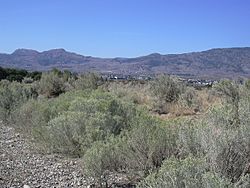Okanagan Desert facts for kids
Quick facts for kids Okanagan Desert |
|
|---|---|

Semi-arid shrubland east of Osoyoos
|
|
| Location | British Columbia and Washington |
| Coordinates | 49°03′15″N 119°31′00″W / 49.05417°N 119.51667°W |
| Part of | Columbia Plateau (CEC) Palouse grasslands (WWF) |
The Okanagan Desert is a special place in the Okanagan Valley of British Columbia, Canada, and Washington, USA. Even though it's called a "desert," it's actually a semi-arid shrubland. This means it's a dry area with lots of shrubs, but not as dry as a true desert. It's the only place like this in Canada! The town of Osoyoos is right in the middle of it.
Part of this unique area is also known as the Nk'mip Desert by the Osoyoos Indian Band. It's the same type of land as other shrublands in the region.
Contents
What Makes This Desert Special?
The Okanagan shrub-steppe (another name for this dry, shrubby land) is home to a special plant called antelope-brush. Many plants and animals found here don't live anywhere else in Canada.
This area is super important for wildlife. About 30% of the animals listed as "Red-listed" and 46% of those "Blue-listed" in British Columbia live here. "Red-listed" means they are threatened or endangered, meaning they are at risk of disappearing forever. "Blue-listed" means they are of special concern. More than 24 types of invertebrates (animals without backbones, like insects) live only in the Okanagan Desert. Another 80 species of invertebrates are found nowhere else in Canada.
Experts like the Commission for Environmental Cooperation (CEC) say this region is part of the Columbia Plateau ecoregion. An ecoregion is a large area with similar climate, plants, and animals. This area has a dry, semi-arid climate and is mostly covered in shrublands and grasslands with very few trees. As you go north, it slowly changes into a different ecoregion near Skaha Lake.
The World Wide Fund for Nature (WWF) also has its own way of defining ecoregions. They say this area is part of the Palouse grasslands ecoregion. Both groups agree that this region has a dry climate and similar types of plants.
Plants of the Desert
The Okanagan shrub-steppe is mostly covered by antelope brush and common rabbitbrush. You can also find many beautiful flowering plants here, such as:
Animals of the Desert
In 2009, 23 animal species in the South Okanagan shrub-steppe were "Red-listed." This means they were either threatened or extirpated (meaning they no longer live in this specific area, even if they exist elsewhere). Some of these animals include:
- Burrowing owl
- Western screech owl
- Peregrine falcon
- Sage grouse
- Sage thrasher
- Pallid bat
- Western red bat
- Badger
- Tiger salamander
- Western ridge mussel
- Northern leopard frog
Protecting the Desert
Over the past few years, many fruit orchards in the area have been changed into vineyards, which are farms for growing grapes. These vineyards need irrigation (watering), which can affect the desert's natural balance.
Local Heroes
Many groups are working to protect the Okanagan Desert:
- The Osoyoos Indian Band runs the Nk'Mip Desert Cultural Centre. This center is part of their resort and winery complex near Osoyoos. It teaches people about the desert and its importance.
- The Osoyoos Desert Society is a non-profit group started in 1991. They manage the Osoyoos Desert Centre, which is a 67-acre (about 0.27 square kilometers) nature center. You can visit it to learn about the desert's plants and animals. It's about 3 kilometers north of Osoyoos off Highway 97.
- The Osoyoos Lake Water Quality Society focuses on how the desert ecosystem affects Osoyoos Lake. They help the community understand and protect the lake.
A New National Park?
There's a plan to create a new national park in this region called the South Okanagan—Similkameen National Park Reserve. If it happens, it would help protect this special desert for future generations.
See More
The Okanagan Desert was featured in a 1999 National Film Board of Canada documentary called Pocket Desert - Confessions of a Snake Killer.

